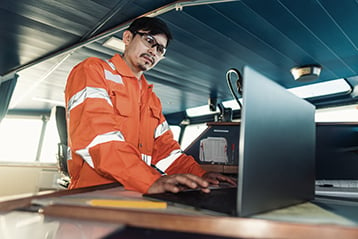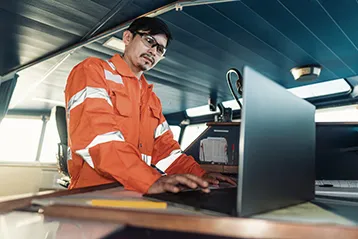DNV has submitted the classification Society’s rules and standards for industry hearing. Planned publication is July 2024. This is the largest collection of documents that DNV has ever submitted for hearing, consisting of 125 documents.
Relevant for ship and offshore unit owners and managers as well as designers, yards and equipment manufacturers.

Industry feedback on rule proposals is essential for meeting market expectations. Thus, DNV welcomes comments in the hearing period from 1 March to 12 April.
DNV introduced an industry-leading tool in 2023 for commenting on proposed rules and standards. The tool is fully integrated into our Rules and Standards Explorer and offers the possibility to provide comments and receive DNV’s feedback within the tool. The Rules and Standards Explorer provides secure and individual comment handling, with no sharing of data between commenters.
The complete list of documents submitted for a hearing can be found in the top menu of the Rules and Standards Explorer.
These are the most important changes to the DNV rules and standards in 2024 on which now a hearing is being held:
- New structure of the fleet-in-service rules
- Introducing separate class notations for in-operation requirements
- The class notation Cyber secure will become mandatory for certain vessel types contracted on or after 1 July 2024.
- New class notation Gas fuelled hydrogen – adding hydrogen to list of accepted non-conventional fuels
- New class notation OCCS – onboard carbon capture and storage
- Updated class notation Clean design – in line with the update of the relevant IMO resolutions
- New class notation Stability pontoon – structure and systems of stability pontoons, heavy lift operations
- New class notation Hatchcoverless – introduction of new qualifier NC
- New class notations Fish carrier and Live fish carrier – for vessels carrying fish as cargo
- New class notation BOG control – tank pressure and temperature control
- Class notation for alternative survey programmes, ASP design, renaming of the existing ASP – a new qualifier Trading is also offered
- Updates of rules for Offshore units, including class rules for floating spaceports
- Updates of rules for Naval vessels, and Underwater technology
Common topics
- New structure of the fleet-in-service rules
- These are now structured to offer more complete information on the class retention systematics, alternative retention scheme possibilities and separate retention requirements.
- Introducing separate class notations for in-operation requirements
- This part clarifies operational requirements previously being included in the vessel design requirements, typically found under the additional class notations of Pt.6.
- The separation of design and operational requirements also makes it possible for owners and managers to better highlight advanced follow-up procedures and reporting processes for their vessels.
- The in-operation notations are found in new Pt.8 of the rules.
- The 2024 edition of the rules does not provide a complete set, these will be further developed in future editions.
- The class notation Cyber secure will become mandatory for certain vessel types contracted on or after 1 July 2024.
- This mandatory requirement follows an update of the IACS unified requirements E26 and E27.
- Further information on this may be found here.
Rules for ships
- Introducing a new class notation Gas fuelled hydrogen
- The notation adds hydrogen to the list of accepted nonconventional fuels that may be used on vessels classed with DNV.
- Hydrogen as fuel is presently not covered by statutory regulations, thus the class rules offer the industry a framework for safe and environmentally friendly design and arrangement.
- Introducing a new class notation EV for fire protection of cargo areas in car carriers intended for carriage of electrical vehicles.
- Introducing a new class notation OCCS for carbon capture and storage onboard vessels
- The new notation offers a framework and requirements supporting design and arrangement for the purpose of reducing CO2 emissions to air by means of capture and storage until delivery ashore.
- The rules for environmental class have been revised and now offer the updated notation Clean design.
- The revision follows the update of IMO resolutions on environmental topics, lifting the statutory regime to the previous content of the rules.
- The notation Clean design – Pt.6 Ch.7 Sec.2 – offers an extended set of requirements compared to the statutory regime and thus gives vessel owners the possibility to show the more advanced capabilities of vessels related to emissions to air, discharges to sea and deliveries to shore.
- Introducing the new class notation Stability pontoon
- The introduction of stability support pontoons during heavy lift operations some years ago is now fully supported by the new class notation setting requirements to the structure and systems.
- Class notation Hatchcoverless – introduction of new qualifier NC
- The industry has requested the possibility to identify hatchcoverless vessels not carrying combustible cargo and thus being accepted with a reduced arrangement for fire detection and extinguishing. DNV is meeting this request by offering the new qualifier NC.
- New class notations for vessels carrying fish as cargo – Fish carrier and Live fish carrier
- The notation sets requirements for vessels carrying fish in holds with sea or fresh water, using under and overpressure for loading and unloading.
- The rules provide strength requirements for the tank structure, stability requirements, and requirements for the piping systems used during loading and unloading.
- New class notation BOG control
- The notation offers a framework for pressure and temperature control in liquefied gas storage tanks, both cargo and fuel tanks. The notation provides criteria for the design and arrangement of such systems.
- Class notation for alternative survey programmes – ASP
- The notation has been adapted in line with the new inoperation notations and has been renamed ASP design.
- To meet market needs for a flexible survey scheme for gas carriers, a new qualifier Trading is offered.
Offshore units
- New service notation Floating spaceports added to DNVRU-OU-0571
- The new service notation covers specific requirements for units and installations intended for launch and/or recovery of spacecraft.
- Major restructuring of DNV-RU-OU-0104 Self-elevating units, including wind turbine installation units and liftboats
- DNV-RU-OU-0104 has been restructured to align it with other DNV-RU-OU rules
- Major update to the diving systems standard (DNV-OSE402) following the updated IMO diving code
- Restructuring of our structural design standards (DNV-OSC101, DNV-OS-C102, DNV-OS-C103 and DNV-OS-C104)
- Common requirements for all structure types have been moved to DNV-OS-C101, with hull-shape-specific requirements included in the respective standard (DNV-OS-C102 for ship-shaped hulls, DNV-OS-C103 for semi-submersible hulls, and DNV-OS-C104 for self-elevating hulls)
Rules for naval vessels
DNV introduced the first parts of a dedicated rule regime for naval vessels in 2021. In 2024, we complete the rule set by incorporating rules for hull structures, systems, ship types and additional notations.
The hearing of the rules for naval vessels will take place from 8 March to 12 April.
Rules for underwater technology
Smaller changes and updates in the rules for manned submersibles and unmanned underwater vehicles.
References
Rules and Standards Explorer
Introduction to July 2024 FIS rules on hearing
